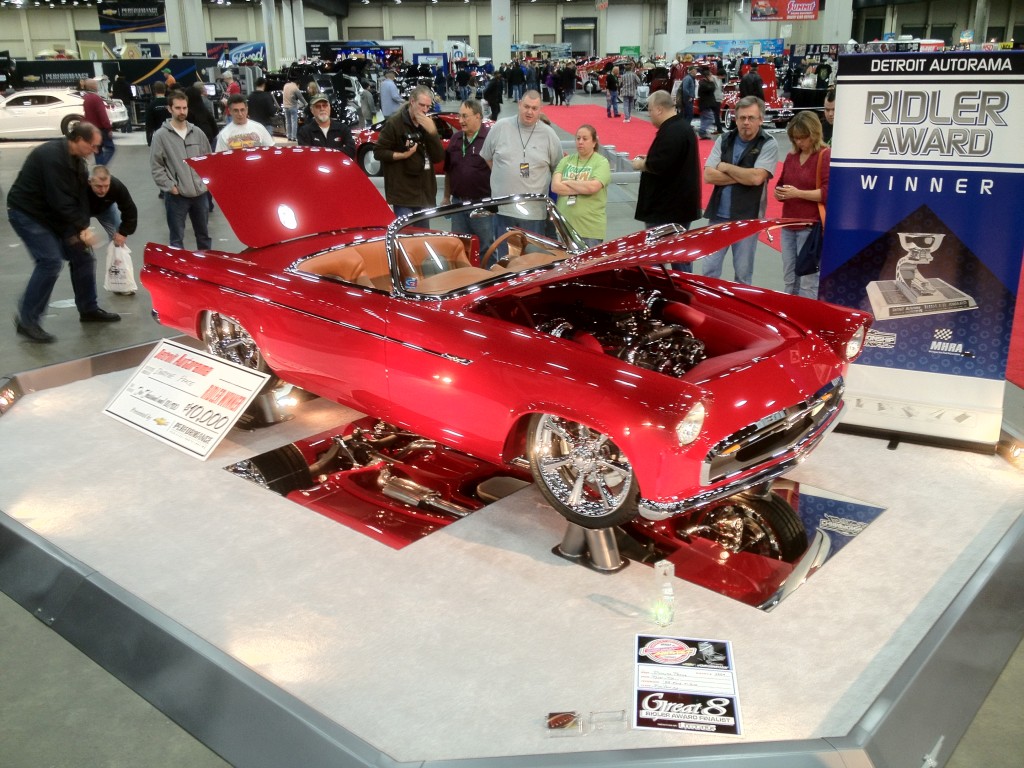
This 1955 Thunderbird rolled to a 2012 Ridler Award on 20-inch front rims and 19-inch rear wheels. Image/Championship Autoshows
Living large is the American way, and that even goes for the wheels and tires on our hot rodded cars and trucks. There was a time not long ago when a 16- or 17-inch wheel and tire combination was huge. Now, 18- to 20-inch wheels have joined in the hot rod party.
There is plenty of debate out there on the merits of plus-sized wheels and tires (we’ll leave that to you), but there is no debating the need to take these three steps before ordering your big-by-large rims and skins:
1. Watch Your Backspacing
One of the most critical measurements is wheel backspacing. This is the distance from the back edge or lip of the wheel down to the wheel’s mounting pad. Backspacing is important because it determines where the wheel sits in the wheelwell.
Check out this article to see what backspacing looks like and how to measure it.
Less backspacing (smaller distance between the mounting pad and back edge) pushes the wheel toward the outside of the vehicle; many front-wheel drive wheels are like this. More backspacing (larger distance between the mounting pad and the back edge) moves the wheel further into the wheelwell; a reverse-style or deep-dish wheel is good example.
Nine times out of ten, you’ll need backspacing that is different from the stock wheel’s backspacing to get larger wheels to fit (especially wider wheels).
2. Make Some Calculations
Since you’re trying to stuff larger wheels and tires into a space designed for something smaller, you need to consider the overall size of the wheel and tire package.
A good starting point is to use one of the many online wheel and tire sizing calculators available on the Internet.
Here’s one of the most complete calculators we’ve seen. Just enter the sizes and offsets of both your present wheels and tires, and of the ones you wish to use. You’ll be rewarded with a comparison of ride height, inboard/outboard dimensions, track width, and much more. You can even see the effect the new wheels and tires will have on gearing and speedometer error!
While the sizing calculator will get you in the ballpark, it doesn’t take into account clearances between the tire and suspension components, brake lines, and the inner wheelwells.
3. Check For Clearance
As a rule of thumb, you want at least 1/4 to 1/2 inches of space between the tire and anything in the wheelwell. If the dimensions of the new wheel and tire cross into that space, you’ll need to go to a smaller-diameter wheel, a lower-profile tire, different wheel backspacing and/or make vehicle modifications (rolling the fender lip, inner fenderwell surgery, etc.), or a combination of the above.
There are two methods to determine clearance.
The first method requires a tape measure and your existing wheels and tires. Simply take measurements from the tire to various points of the inner wheelwell and any brake or suspension components. Be sure to measure all four wheels to account for differences in sheetmetal tolerances and such, and make sure to measure the front wheels both straight and at full lock (turned fully to the left and right). Clearances can get very tight at full lock, especially with the inner fenderwells.
The other method for determining fitment is by using the Wheelrite fitment tool from Percy’s High Performance. This affordable tool simulates wheel width, wheel diameter, bolt pattern, backspacing, and tire profile right on your vehicle. Just bolt the Wheelrite to your brake hub, adjust the tool to the dimensions of the wheel and tire you wish to use, and rotate the tool to see if there’s adequate clearance. The Wheelrite can simulate four- and five-lug wheels from 15 to 30 inches in diameter.
Considering how much a set of custom wheels and tires cost—and that once you mount them, you own ’em—using a tool like the Wheelrite is cheap insurance.
Now, the fun part…picking out your new wheels and tires. Good luck!

[…] quide to measuring wheel bolt pattern and backspacing. Along with our articles on wheel offsets and wheel/tire plus-sizing, this information will help you take essential steps toward selecting the right wheels for your […]
When looking for big wheels and tires, you should always be sure to check the clearances. Like you said, you want at least a 1/2 inch. If there is less, then there is a chance that the wheel will rub or hit the inside of the wheel well. Also, do be sure that they fit the car or truck!